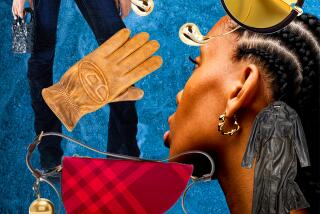Sunglasses keep their cool
- Share via
In Southern California, it’s not uncommon to pop open a glove box and unleash an avalanche of sunglasses. Many of us amass multiple pairs, or we have friends who stash what seems like dozens of styles in their cars, bags, closets and coat pockets. Some are boardwalk specials; others are top of the line frames that are stowed in plush cases. After all, we live in a place where the average number of sunny or partially sunny days hovers somewhere around 325 a year.
FOR THE RECORD:
Sunglass trends: In a Sunday Image section article about trends in sunglass design and in another article about niche designers launching sunglass lines, the name of eyewear manufacturer Luxottica Group was misspelled as Luxxotica Group.
Besides the obvious protection factor, sunglasses are a simple way to further accessorize and, sometimes, even serve as a mini-makeover. You know that superhero who slips on a mask and transforms into his alter ego? Well, sunglasses can make us feel tough or feminine or, in true L.A. fashion, like a disheveled off-duty celebrity, within seconds.
“They are the fun buy and can be something totally out of your comfort zone,” says Joy Gibb, a licensed optician and consultant for the Vision Council of America. And apparently, our fun factor is on the rise. NPD, a market research group, reports that the number of pairs sold in January to March, 2010, increased 8% over the same time period last year.
“It’s partially due to people trading down, away from expensive [accessories] toward something that is a couple hundred of dollars or less,” says Daniel Hofkin, a research analyst for the Chicago-based investment firm William Blair & Co., who adds that glasses priced at $30 and under have proved to be “the most popular with consumers and resilient through the down economy.” (According to NPD, this year buyers are purchasing sunglasses that average $15.49 per pair.)
Another reason sales are on the rise may have something to with rapidly changing eyewear trends and designers who are becoming more creative and adventurous with shape and color. “We’ve seen that for a lot of people it’s no longer enough to just wear [Ray Ban] Wayfarers every day,” says Kristen McCabe associate vice president of sun and luxury products for Luxxotica Group, the company that manufactures glasses for companies such as Chanel and Tiffany & Co. and which owns Ray Ban. “In order to update their fashion look, people are buying more often and going into stores to see what’s different.”
For summer, the big trends include bold colors, patterns and new takes on the classic aviator. Prada’s “Postcard” collection, for example, is a group of 1960s-style acetate frames that come in Day-Glo colors such as fluorescent pink and lime and have soft-peach colored lenses.
“A lot of it comes back to the geek chic trend that’s been going on for a few years,” says McCabe, referring to oversized, rectangle frames that are manufactured in colorful translucent materials.
Ray Ban Wayfarers have been updated with patterned frames, including a “Rare Prints” collection, which ranges from a New York subway map to psychedelic swirls.
Fashion brands are also using eyewear to connect runway collections and accessories. Miu Miu has transferred the dainty bird print seen on some of its spring/summer 2010 collection to the stems of its current sunglasses line, and Burberry’s warm honey frames evoke the company’s classic tan trench coats.
And though the aviator has never really gone away, designers are churning them out for summer in fresh bold colors with a variety of lens options. “We’ve see a huge swing back into metal frames,” says McCabe. “Customers want something lightweight and more comfortable. Color or gradient lenses are also big as they are very soft and feminine. Or on the opposite end of the spectrum is that flash mirror lens that is so Carrie Bradshaw in ‘Sex and the City.’ ”
But though our sunglasses might make us feel like supermodels, it’s the lens quality and protection they provide that counts (and that protection is the primary reason a pair can cost upwards of $300).
“If you spend a lot of time in the sun, or live in a place like California then polarized lenses are a must,” says Gibb, referring to those lenses that have a laminated surface containing vertical stripes designed to eliminate — or at least cut down on — glare. Ten years ago, consumers looked for the “UVA/UVB protection” sticker on the lens, but polarized lenses seem to be today’s must-have technology. In fact, retailers such as Sunglass Hut are prioritizing function before fashion, designating areas of their stores specifically to showcase sunglass styles that have polarized lenses.
Polarized lenses have a laminated surface containing vertical stripes that act like blinds on a window to eliminate glare from sun that bounces off of cars, the street or snow.
Gibb warns that for people who don’t wear sunglasses, cumulative exposure to the sun can result in cataracts, photokeratits or sunburn of the eye. “Polarized lenses will reduce the glare that comes off the street, snow and other cars from all angles,” says Gibb. “This improves visual acuity, contrast and reduces eye strain and glare. It’s a safety thing.”
And, she adds: “Ninety-nine to 100% of polarized lenses will also come with UVA/UVB protection, but it’s always good to ask.”






